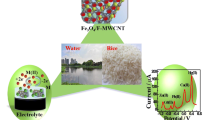Abstract
An application of the standard addition method to stripping voltammetry of solid materials immobilized in inert electrodes is described. The method allows the determination of the mass fraction of a depositable metal M in a material on addition of known amounts of a standard material containing M to a mixture of that material and a reference compound of a second depositable metal, R. After a reductive deposition step, voltammograms recorded for those modified electrodes immersed in a suitable electrolyte produce stripping peaks for the oxidation of the deposits of M and R. If no intermetallic effects appear the quotients between the peak areas and the peak currents for the stripping oxidation of M and R vary linearly with the mass ratio of the added standard and the reference compound, thus providing an electrochemical method for determining the amount of M in the sample. The method has been applied to the determination of Zr in minerals, ceramic frits, and pigments, using ZnO as reference material and ZrO2 as the standard.







Similar content being viewed by others
References
Scholz F, Meyer B (1994) Chem Soc Rev 23:341
Scholz F, Lange B (1992) Trends Anal Chem 11:359
Scholz F, Meyer B (1998) In: Bard AJ, Rubinstein I (eds) Electroanalytical chemistry, a series of advances, vol 20. Marcel Dekker, New York pp 1–87.
Grygar T, Marken F, Schröder U, Scholz F (2002) Collect Czech Chem Commun 67:163
Lamache M, Bauer D (1979) Anal Chem 51:1320
Brainina KhZ, Vidrevich MB (1981) J Electroanal Chem 121:1
Scholz F, Nitschke L, Henrion G (1989) Naturwiss 76:71
Scholz F, Nitschke L, Henrion G, Damaschun F (1991) Naturwissenschaften 76:167
Doménech A Anal Chim Acta, (in press)
Wang J (1985) Stripping analysis, principles, instrumentation and applications. Wiley-VCH, Weinheim
Clark RJH, Bradley DC, Thornton P (1975) The chemistry of titanium, zirconium and hafnium. Pergamon Press, Oxford
Bückel KH, Moretto HH, Woditsch P (2000) Industrial inorganic chemistry. Wiley-VCH, Weinheim
Alarcón J (2000) J Eur Ceram Soc 20:1749
Llusar M, Calbo J, Badenes JA, Tena MA, Monrós G (2001) J Mater Sci 36:153
Badenes JA, Vicent JB, Llusar M, Tena MA, Monrós G (2002) J Mater Sci 37:1413
Taylor L (2001) Ind Miner 409:73
Romero M, Rincón JM, Acosta A (2003) J Eur Ceram Soc 23:1629
Castillone RJ, Sriram D, Carty WM, Snyder RL (1999) J Am Ceram Soc 24:2819
Bach H, Krause D (1999) Analysis of the composition and structure of glass and glass ceramics. Springer, Berlin Heidelberg New York
Lachance GR, Claisse F (1995) Quantitative X-ray fluorescence analysis, theory and application. Wiley, Chichester
Medicus G, Ackermann G (1991) Fresenius J Anal Chem 339:226
Buhrke VE, Jenkins R, Smith S (eds) (1998) Preparation of specimens for X-ray fluorescence and X-ray diffraction analysis. Wiley-VCH, New York
Bosch-Reig F, Gimeno-Adelantado JV, Sánchez-Ramos S, Yusá-Marco DJ, Bosch-Mossí F (2001) Spectrochim Acta B 56:187
Bosch-Reig F, Gimeno-Adelantado JV, Peris-Martínez V, Bosch-Mossí F (1995) Spectrochim Acta B 50:739
Bosch-Reig F, Gimeno-Adelantado JV, Peris-Martínez V, Yusá-Marco DJ, Bosch-Mossí F, Doménech-Carbó MT (1996) Spectrochim Acta B 51:569
Raith A, Godfrey J, Hutton RC (1995) Fresenius J Anal Chem 354:163
Yang XJ, Pin C (2002) Anal Chim Acta 458:375
Becker JS, Dietze HJ (2003) Int J Mass Spectrom 228:127
Tsolakidou A, Buxeda i Garrigós J, Kilikoglou V (2002) Anal Chim Acta 474:17
Becker JS (2002) Spectrochim Acta B 57:1805
de Vries WT, Van Dalen E (1967) J Electroanal Chem 14:315
Lovric M, Komorsky-Lovric S, Bond AM (1991) J Electroanal Chem 319:1
Lovric M, Komorsky-Lovric S (1988) J Electroanal Chem 248:239
Lovric M, Komorsky-Lovric S (1989) Fresenius J Anal Chem 334:289
Komorsky-Lovric S, Lovric M, Bond AM (1992) Anal Chim Acta 258:299
Doménech A, Doménech MT, Osete L, Gimeno JV, Bosch F, Mateo R (2002) Talanta 56:161
Doménech-Carbó A, Sánchez-Ramos S, Doménech-Carbó MT, Gimeno-Adelantado JV, Bosch-Reig F, Yusá-Marco DJ, Saurí-Peris MC (2003) Electroanalysis 15:1465
O’Dea JJ, Osteryoung J, Osteryoung RA (1983) J Phys Chem 87:3911
Dong S, Wang Y (1988) Talanta 35:819
Naumann RS (1992) Fresenius J Anal Chem 343:746
Acknowledgements
The Valencian Regional Government “I+D Generalitat Valenciana” Project CTIDIB/2002/216 is thanked for financial support.
Author information
Authors and Affiliations
Corresponding author
Appendix
Appendix
Analysis of errors
To evaluate the relative uncertainty associated with the mass fraction of M in the sample, ɛMA, we shall use the conventional theory of error propagation. Because the uncertainty of rMS, rRX, MM, and MR is negligible, ɛMA depends on the uncertainties of mMA, mMS, mRX, and those associated with peak current or peak area measurements.
Taking the first, the relative uncertainty in peak current (or peak area) measurements can be expressed as:
where it is assumed that an identical uncertainty Δq(= Δq(M)=Δq(R)) is obtained for the peak areas or peak currents of both stripping processes. Assuming that an identical total charge q(=q(M)+q(R)) passes in the electrochemical experiments, one can obtain:
where H (=HR/HM) represents the coefficient of response associated with the electrochemical measurements. Combining these equations, the relative uncertainty associated to the quantity q(M)/q(R) (or Δip(M)/Δip(R)) is:
The values of ɛ q depend on the values of H and the quotient ΓM/ΓR in an identical way. The position of the minimum of uncertainty depends on the value of these parameters. Because H (=HR/HM) increases on decreasing the ΓM/ΓR ratio, a compromise between both parameters must be found. Thus, for ΓM/ΓR=1, the minimum of ɛ q is obtained for H=1.
For the second, one can take a typical uncertainty Δm (=ΔmMA=ΔmMB=ΔmRX) equal to 0.01 mg. Then, the relative uncertainties of the quotients mMA/mRX and mMS/mRX are:
For fixed values of Δm and the sum of the masses, numerical calculations indicate that the value of such terms is minimal for mMA/mRX and mMS/mRX equal to unity.
Rights and permissions
About this article
Cite this article
Doménech-Carbó, A., Moya-Moreno, M. & Doménech-Carbó, M.T. Standard addition method applied to solid-state stripping voltammetry: determination of zirconium in minerals and ceramic materials. Anal Bioanal Chem 380, 146–156 (2004). https://doi.org/10.1007/s00216-004-2720-0
Received:
Revised:
Accepted:
Published:
Issue Date:
DOI: https://doi.org/10.1007/s00216-004-2720-0



